Mad Hedge Technology Letter
May 8, 2023
Fiat Lux
Featured Trade:
(DON’T LET THESE 3 GET AWAY)
(SNOW), (WDAY), (NOW)

Mad Hedge Technology Letter
May 8, 2023
Fiat Lux
Featured Trade:
(DON’T LET THESE 3 GET AWAY)
(SNOW), (WDAY), (NOW)

Even though the tech market isn’t in a renaissance, that doesn’t mean there aren’t any good choices to park capital.
I’d like to bring readers' attention to 3 cloud stocks that still have some upside.
It’s true that tech stocks no longer go up in a straight line, that auto-pilot mindset blew up spectacularly in 2022 when tech stocks finally stopped defying gravity.
The 16% the Nasdaq has gained this year is somewhat due to the expectations of a rebound and better-than-expected earnings.
With that in mind, software still has legs and it would be a shame to not go where the value is in tech.
After the big 7 behemoths, there are some tech plays that readers need to target because workloads will migrate to the cloud over the next decade.
There has been a significant shift to the cloud in recent years from legacy on-premise workloads and infrastructure. Cloud computing allows organizations to rent rather than buy IT and other functions.
Given the cost savings, scalability, flexibility, productivity gains, and improved security features, it’s obvious why this shift is happening.
These advantages mean more workloads will continue moving to the cloud. SaaS growth stocks are expanding despite the current macro uncertainty.
IT service management giant ServiceNow (NOW) is one to slide into your black leather wallet.
The company is a leader in the cloud-based IT service management and digital workflow solutions sphere. Its software helps businesses streamline operations, automate workflows and improve customer experience.
NOW recently grew revenues by 24% year-over-year last quarter.
It reported a healthy 35% free cash flow margin, which ranks in the top quartile among SaaS growth stocks.
Another one to keep an eye on is Snowflake (SNOW).
Data migration to the cloud is a secular trend that will support growth for years. Snowflake is a cloud-based data warehousing, processing, and analytics company.
Their data platform provides businesses with a scalable and flexible service for managing their data. It enables organizations to store, analyze and share large amounts of data in real-time, helping them to make better decisions and improve their operations.
Over the last five years, it has reported a net revenue retention rate above 150%.
Its platform capabilities are critical for any enterprise, and it has been winning customers in various industries.
On March 1, they reported quarterly revenues of $589 million, a 53% year-over-year growth rate.
Just as impressive, the company announced a plan to return cash to shareholders through a $2 billion buyback.
Lastly, Workday (WDAY) is a cloud-based software company that provides businesses with human capital management, financial management, and analytics solutions.
The company’s cloud software helps businesses improve workforce management, financial management, and decision-making processes.
It counts many Fortune 500 companies as customers. The company hit the 10,000 customers milestone lately with revenue increasing 19.6% year-over-year.
The runway is long for WDAY with a total addressable market for this subsector at $73 billion, respectively. Considering that organizations will continue to modernize HR and finance operations, Workday is one of the top SaaS stocks to buy to play this trend.
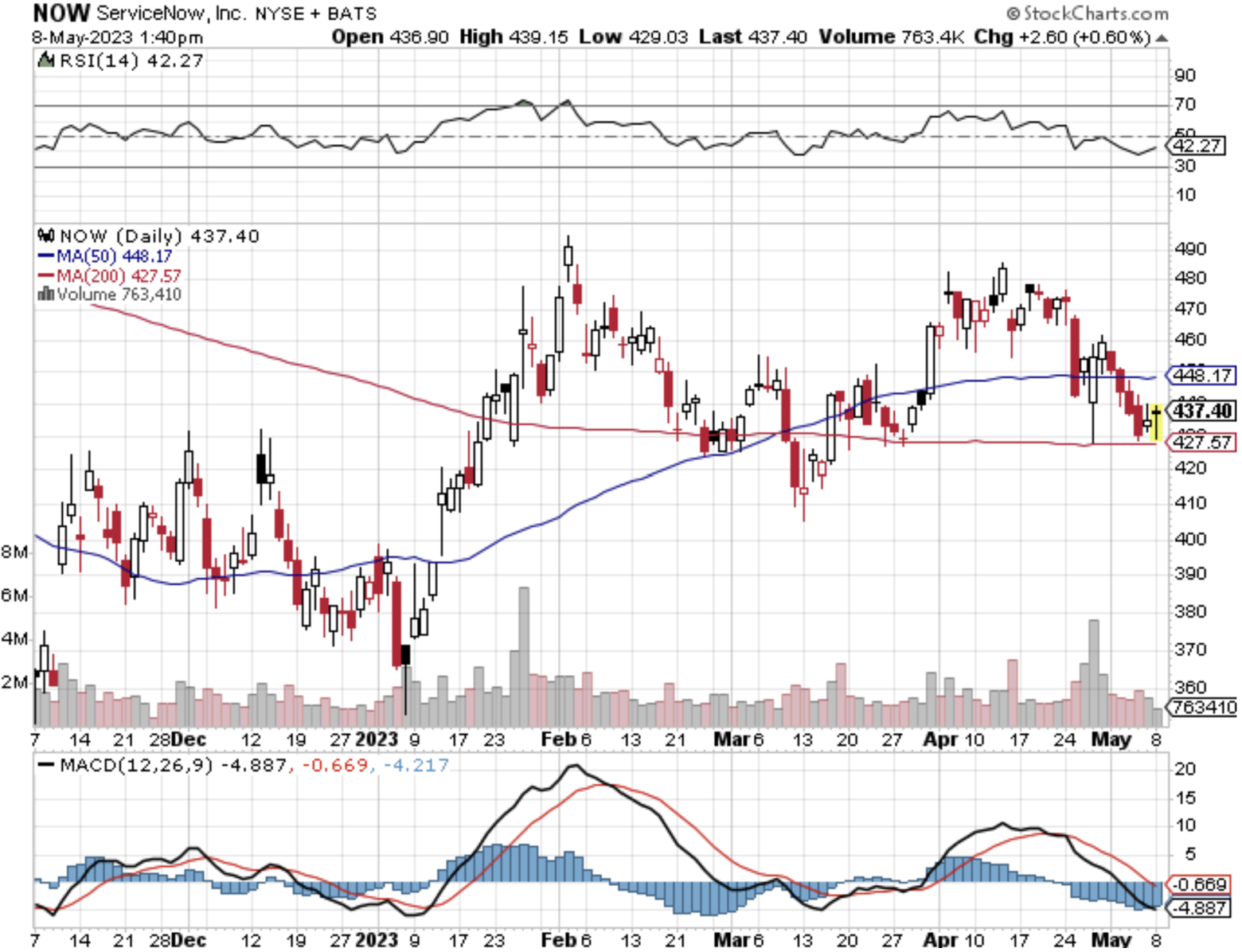
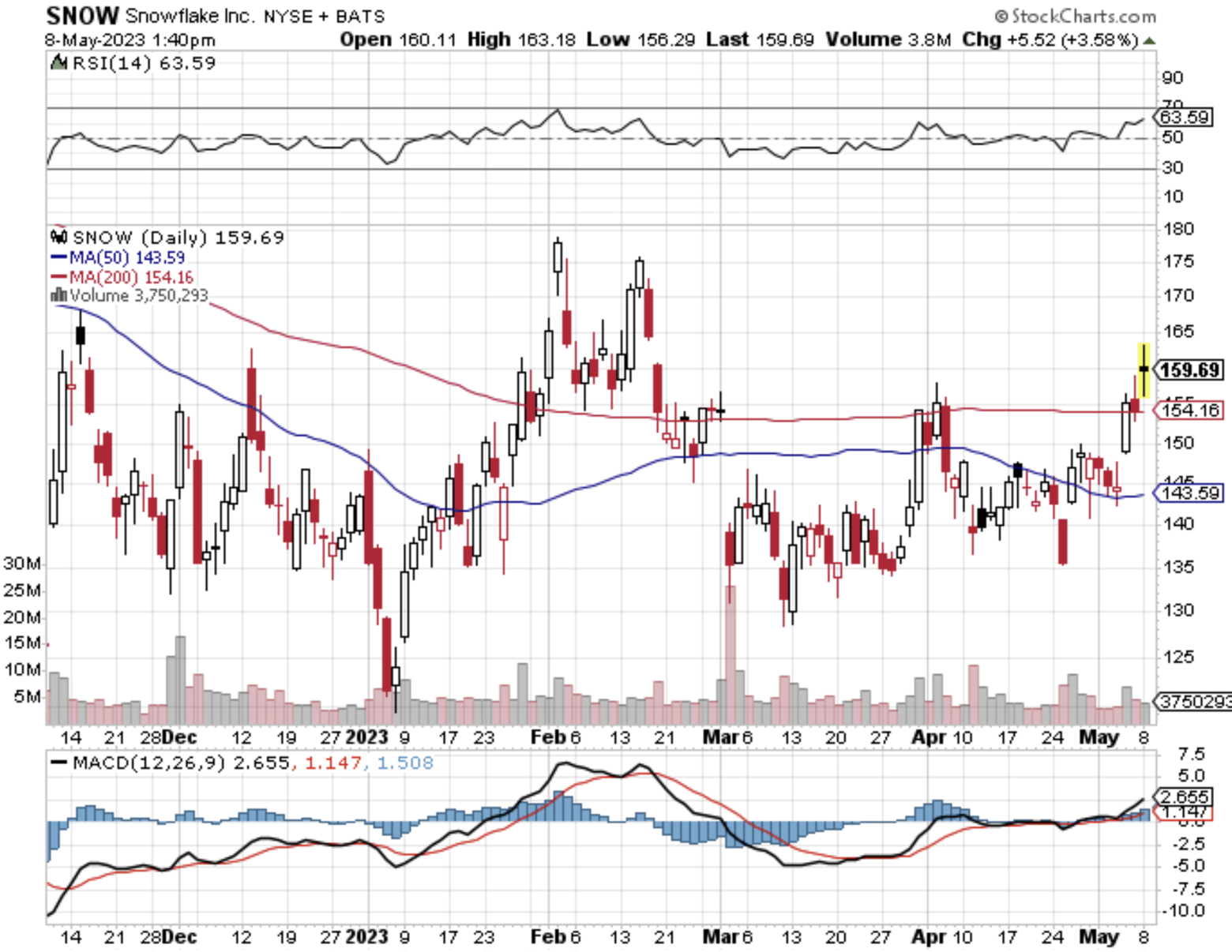
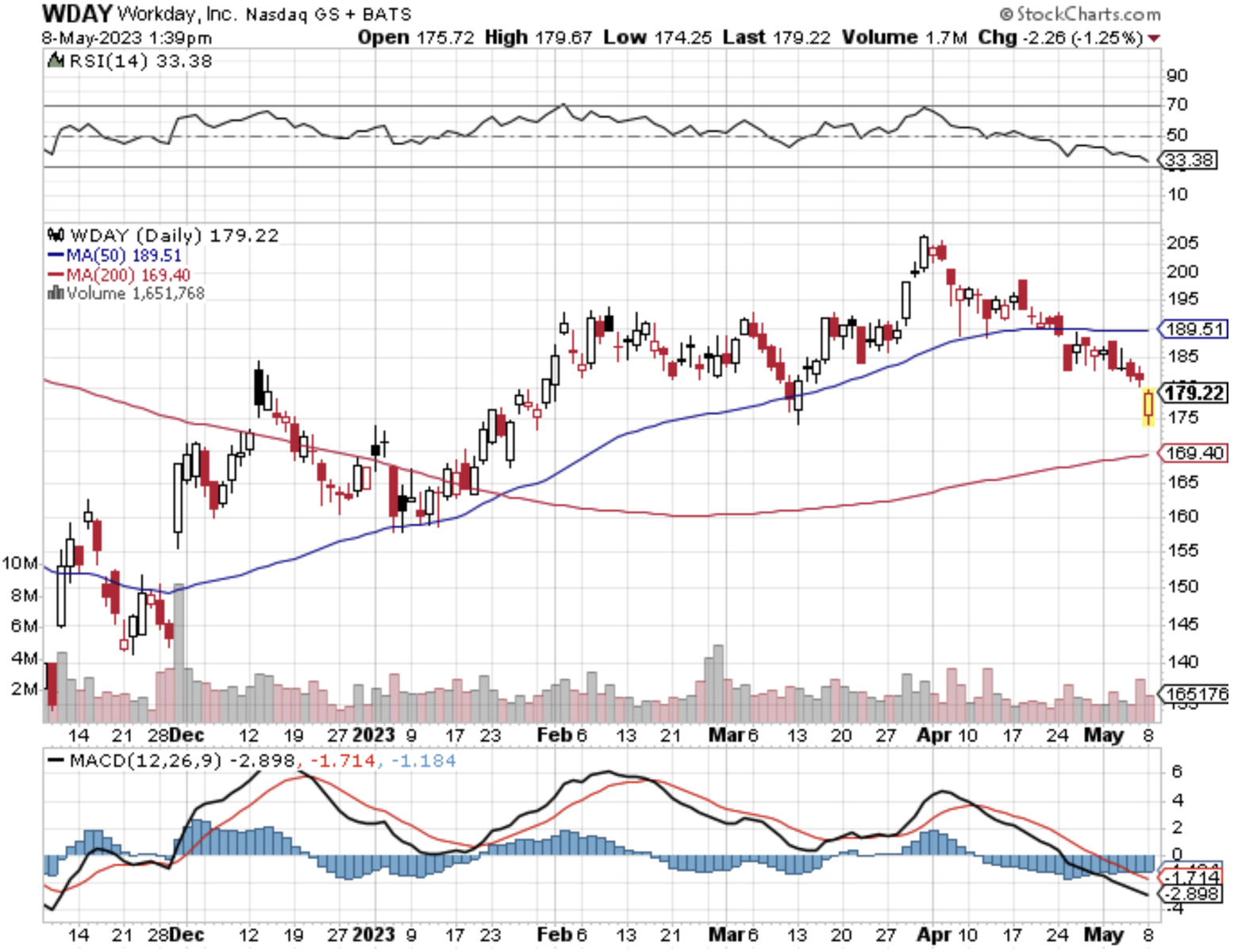
Mad Hedge Technology Letter
March 12, 2021
Fiat Lux
Featured Trade:
(SERVICENOW IS NOW)
(NOW), (PYPL)

After a deluge of positive vaccine news, the bottom line is that there will be more work in 2021.
It has always been about the work.
As much as it seems recently that social media is taking over and that the marketing of work will solve economic problems from Guatemala to Zanzibar instead of the work itself, I have news for you: it won’t.
It is still about the work, and for tech newsletters like this one, it’s about the content and always will be.
Vaccine-based health solutions will release a torrent of new work opportunities, and tech stock readers need to jump into this workflow automation cloud stock called ServiceNow (NOW).
Digital investments are at an all-time high and are expected to continue expanding.
This is the best place to park investment money betting on future digital-based work growth.
According to IDC, worldwide digital transformation investments will total more than $7.4 trillion by 2044.
The digital economy is firing on all cylinders and ServiceNow is the platform company for digital business.
A quick review of 2020 indicates outperformance.
They significantly beat expectations across the board, bringing heightened momentum into 2021 and beyond.
NOW delivered over 30% organic top line growth, 25% operating margins and $1.4 billion in free cash flow.
Their achievement is a testament to ServiceNow’s strong work culture.
The secular tailwinds of digital transformation, cloud computing, and business model innovation have all intersected at a perfect moment in time.
A paradigm shift is occurring worldwide.
In 2020, for the first time in history, digital transformation spending accelerated despite GDP declining globally.
ServiceNow is enabling a comprehensive solution for the schedule and reporting of vaccination for Scotland's most vulnerable citizens.
Within 12 hours of rollout, the NHS (National Health Service) in Scotland booked over 220,000 appointments.
NOW is literally all about the business workflow maximizing enterprise digital transformation with how every organization in every sector in every location.
Workers are adapting, growing, creating new business models, and empowering themselves to be productive in any environment and in condition.
NOW grew billings by more than 40% year over year organically.
They delivered 89 deals greater than $1 million and now have close to 1,100 customers paying over $1 million annually.
This bounty of sales included landing the largest deal in NOWs history and deal sizes overall keep getting larger.
NOW's renewal rate remained best in class at 99%.
In 2020, they added nearly 700 net new customers, ending the year with almost 6,900 enterprises.
The number of giant deals continues uninterrupted with customers paying NOW $5 million or more in annual contract value (ACV) grew over 40% in fiscal 2020.
One of the U.K.'s big four banks is using multiple ServiceNow products, including a purpose-built new financial services operations product to help transform the way it operates and to deliver better customer experiences.
The bank has seen a 70% uptick in efficiency and improvement of payment processing by integrating the Now Platform into its core banking systems.
These bankers moved from cut and paste, swivel chair manual processes to efficient, automated workflows.
In one case, employees went from managing 10 requests an hour to 10,000 requests in three minutes on the Now Platform.
PayPal (PYPL) recently expanded their relationship with ServiceNow as a key partner for elements of their digital transformation.
Nike is another big name who is using the Now Platform to create better customer and employee experiences.
Other additive deals that are noteworthy are in key sectors such as Booking.com in travel and hospitality, BP in energy, Santander U.K. in banking.
Most cloud stocks are high growth and trot out even higher losses, but now NOW!
They run a tight ship with Q4 operating margin of 22%, a 100-basis-point beat versus guidance, fueled by strong top line outperformance.
For full year 2020, operating margin was 25%, up 300 basis points year over year.
Looking forward, only optimism can be described in the corridors of NOW and for Q1, the company expect subscription revenues between $1.275 billion and $1.28 billion, representing 28% to 29% year-over-year growth.
The cloud revolution is still in the early innings and this company has guaranteed $10 billion in annual sales representing a more than doubling of revenue from the $4.52 billion in 2020.
NOW has a strong product portfolio, a deep focus on building deep customer relationships, and a robust commitment to enabling digital transformation.
This cloud company must be in your top 20 of ones to own and the stock price will benefit from this dynamic business.
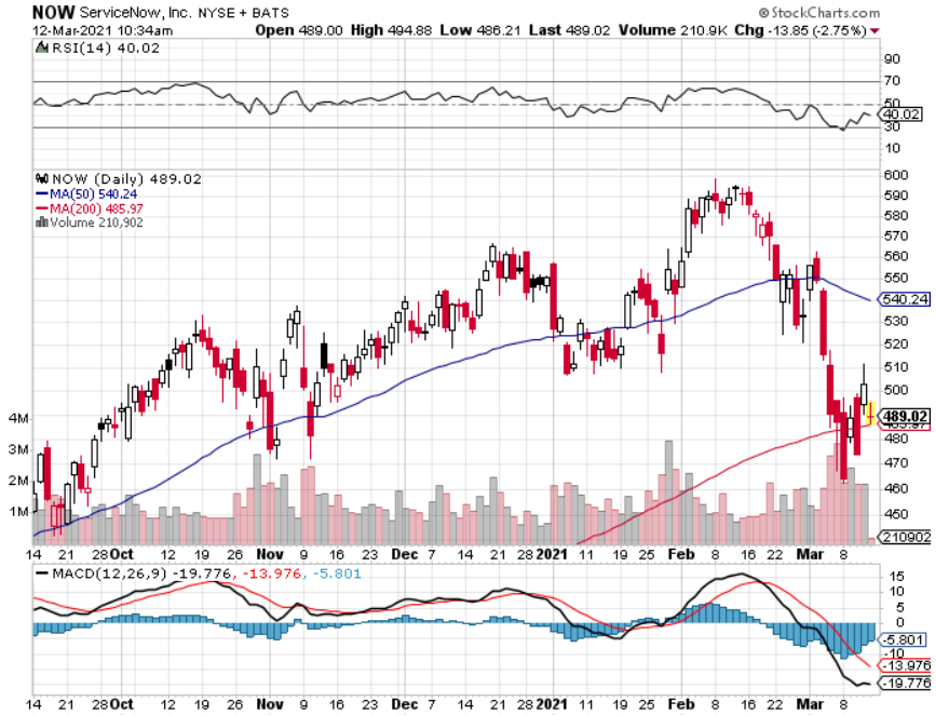
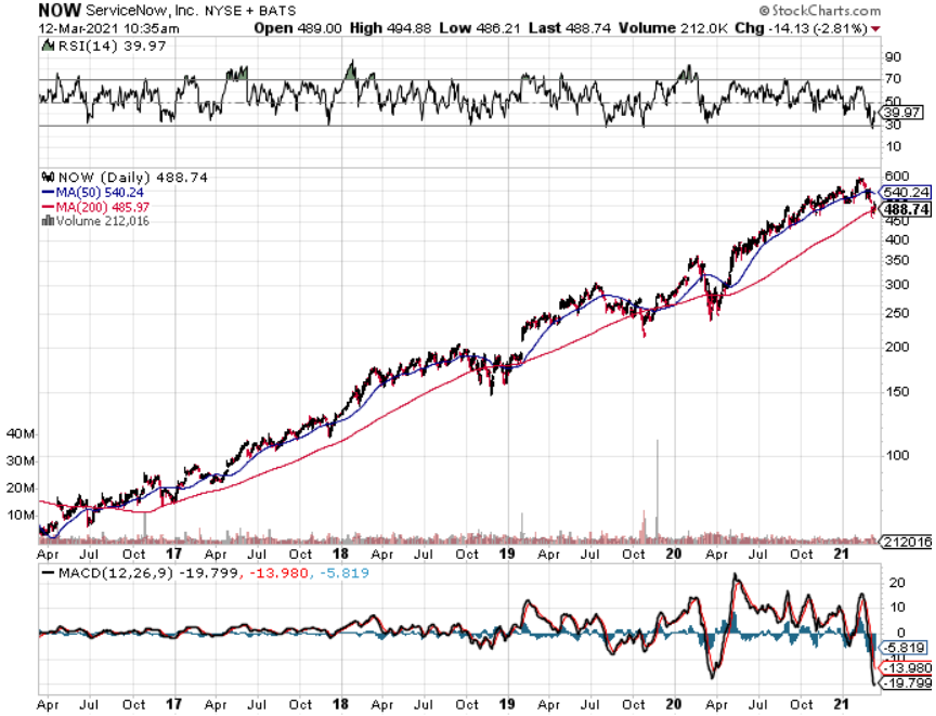

Mad Hedge Technology Letter
December 18, 2020
Fiat Lux
Featured Trade:
(TECH IN 2021)
(ZM), (WORK), (NVDA), (AMD), (QCOM), (SQ), (PYPL), (INTU), (PANW), (OKTA), (CRWD), (SHOP), (MELI), (ETSY), (NOW), (AKAM), (TWLO)

The tech sector has been through a whirlwind in 2020, and if investors didn’t lose their shirt in March and sell at the bottom, many of them should have ended the year in the green.
My prediction at the end of 2019 that cybersecurity and health cloud companies would outperform came true.
What I didn’t get right was that almost every other tech company would double as well.
Saying that video conferencing Zoom (ZM) is the Tech Company of 2020 is not a revelation at this point, but it shows how quickly a hot software tool can come to the forefront of the tech ecosystem.
M&A was as hot as can be as many cash-heavy cloud firms try to keep pace with the Apples and Googles of the tech world like Salesforce’s purchase of workforce collaboration app Slack (WORK).
Not only has the cloud felt the huge tailwinds from the pandemic, but hardware companies like HP and Dell have been helped by the massive demand for devices since the whole world moved online in March.
What can we expect in 2021?
Although I don’t foresee many tech firms making 100% returns like in 2020, they are still the star QB on the team and are carrying the rest of the market on their back.
That won’t change and in fact, tech will need smaller companies to do more heavy lifting come 2021.
The only other sector to get through completely unscathed from the pandemic is housing, and unsurprisingly, it goes hand in hand with converted remote offices that wield the software that I talk about.
The world has essentially become silos of remote offices and we plug into the central system to do business with each other with this thing called the internet.
In 2021, this concept accelerates, and cloud companies could easily check in with 20%-30% return by 2022. The true “growth” cloud firms will see 40% returns if external factors stay favorable.
This year was the beginning of the end for many non-tech businesses and just because vaccines are rolling out across the U.S. doesn’t mean that everyone will ditch the masks and congregate in tight, indoor places.
There is nothing stopping tech from snatching more turf from the other sectors and the coast couldn’t be clearer minus the few dealing with anti-trust issues.
I can tell you with conviction that Facebook, Google, Apple, and Amazon have run out of time and meaningful regulation will rear its ugly head in 2021.
We are already seeing the EU try to ratchet up the tax coffers and lawsuits up the wazoo on Facebook are starting to mount.
Eventually, they will all be broken up which will spawn even more shareholder value.
Even Fed Chair Jerome Powell told us that he thinks stocks aren’t expensive based on how low rates have become.
That is the green light to throw new money at growth stocks unless the Fed signal otherwise.
As we head into the 5G world, I would not bet against the semiconductor trade and the likes of Nvidia (NVDA), AMD (AMD), Qualcomm (QCOM) should overperform in 2021.
Communication is the glue of society and communications-as-a-platform app Twilio (TWLO) will improve on its 2020 form along with cloud apps that make the internet more efficient and robust like Akamai (AKAM).
Workflow cloud app ServiceNow (NOW) is another one that will continue its success.
The uninterrupted shift to the cloud will not stop in 2021 and will be a strong growth driver for numerous tech companies next year.
I will not say this is a digital revolution, but as corporate executives realize they haven’t spent enough on the cloud in the lead-up to the pandemic and must now play catch-up in order to satisfy new demands in the business.
The most recent CIO survey was the thesis that cloud and digital adoption at 10% of enterprise and 15% of consumer spend entering 2020 would continue to accelerate post-pandemic and into 2021-2022.
A key dynamic playing out in the tech world over the next 12 to 18 months is the secular growth areas around cloud and cybersecurity that are seeing eye-popping demand trends.
Consumers will still be stuck at home, meaning e-commerce will still be big winners in 2021 such as Shopify (SHOP), Etsy (ETSY), and MercadoLibre (MELI).
The reliance on e-commerce will open the door for more tech companies to participate in the digital flow of transactions and the U.S. will finally catch up to the Chinese idea of paying through contactless instruments and not cards.
This highly benefits U.S. fintech companies like Square (SQ) and PayPal (PYPL). Intuit (INTU) and its accounting software is another niche player that will dominate.
Intuit most recently bought Credit Karma for $8.1 billion signaling deeper penetration into fintech.
Since we are all splurging online, we need cybersecurity to protect us and the likes of Palo Alto Networks (PANW), Okta (OKTA), and CrowdStrike Holdings, Inc. (CRWD).
The side effect of the accelerating shift to digital and cloud are troves of data that need to be stored, thus anything related to big data will also outperform.
Most of the information created (97%) has historically been stored, processed, or archived.
As new mountains of digital gold are created, we expect AI will have an increasingly critical role.
I believe that 2021 will finally see the integration of 5G technology ushering in another wave of digital migration and data generation that the world has never seen before and above are some of the tech companies that will make out well.
The average household is using 38x the amount of internet data they were using ten years ago and this is just the beginning.
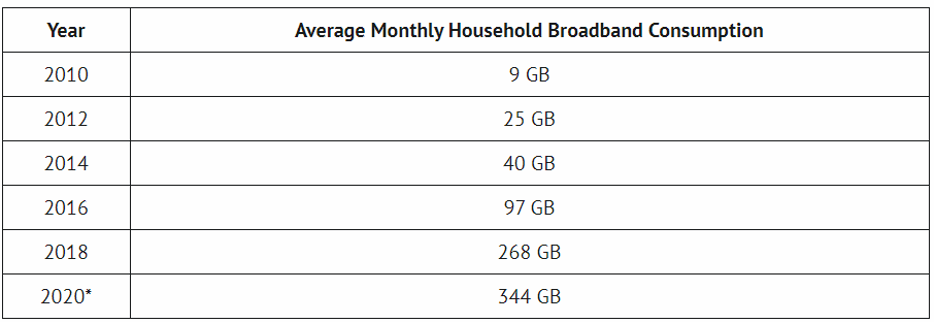
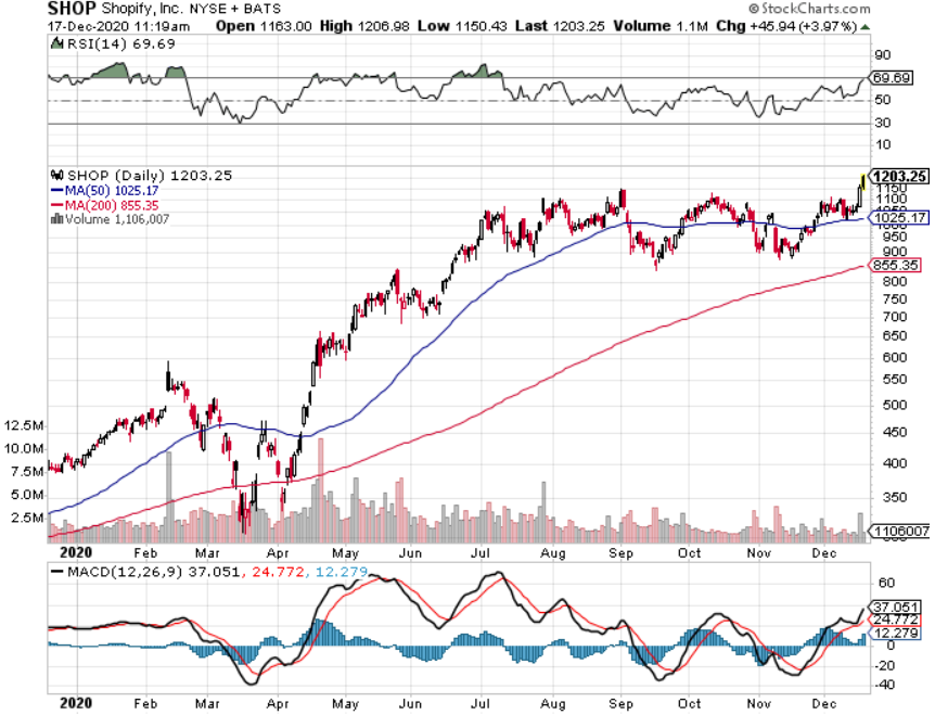

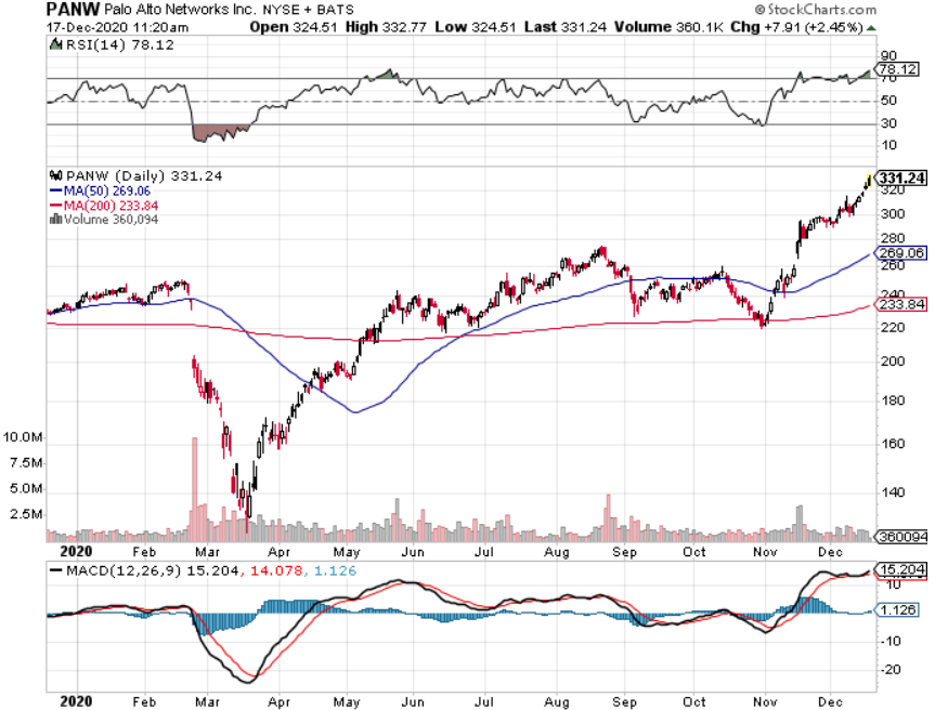
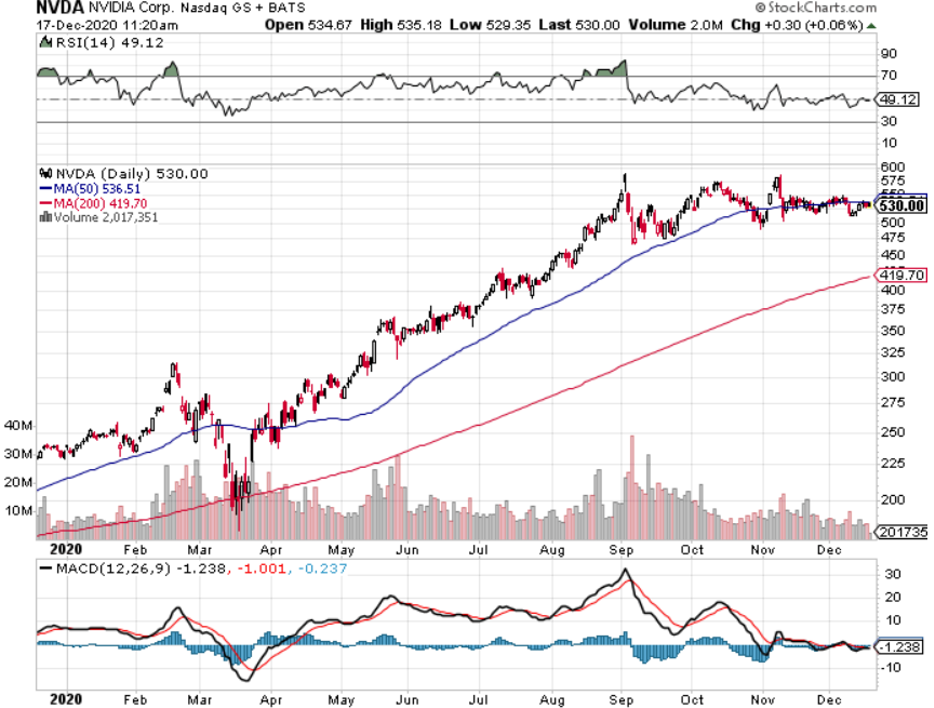
Mad Hedge Technology Letter
December 16, 2020
Fiat Lux
Featured Trade:
(THE NEW SALESFORCE)
(NOW), (CRM), (SAP), (ORCL), (IBM), (MSFT)

During Bill McDermott’s leadership as CEO, German software firm SAP's market value increased from $39 billion to $156 billion.
No doubt that this experience at SAP paved the way to become one of the fastest-growing major cloud vendors in 2020.
McDermott is now CEO of ServiceNow (NOW), a company that offers specific IT solutions. It allows you to manage projects and workflow, take on essential HR functions, and streamline your customer interaction and customer service. It does all of this, thanks to a comprehensive set of ServiceNow web services, as well as various plug-ins and apps.
Their market value has doubled to $100 billion and this is just the beginning.
ServiceNow almost doesn’t exist after numerous attempts to be acquired, like the time it was almost sold to VMware for $1.5 billion.
Company founder Fred Luddy, who is now chairman, and the board of directors were intrigued by the VMware offer, but venture-capital firm Sequoia Capital argued that $1.5 billion wasn’t a premium at that time let alone market rate for this burgeoning cloud player.
Then-CEO Frank Slootman was eventually replaced by former eBay Inc. (EBAY) CEO John Donahoe in February 2017, who took the company to $3.46 billion in annual 2019 sales.
Donahoe then bolted for Nike Inc. (NKE), and McDermott joined from SAP, locking in the firm for a new era of meteoric growth.
ServiceNow is now on its way to become the defining enterprise-software company of the 21st century and if you look at their position in the market today, they’re the only born-in-the-cloud software company to have surpassed $100 billion market cap without large-scale M&A.
This underdog cloud company whose automation software is deployed to improve productivity is leading to what is known as a “workflow revolution.”
Their set of software tools fused with the sudden emphasis on digital tracking of employees and business systems — has played into ServiceNow’s strengths.
The seismic shift is accelerating: By 2025, most of the millennial generation will work from home permanently, based on internal company reports.
It expects revenue of $4.49 billion in fiscal 2020 and still has a mountain to climb with revenue of just 20% of Salesforce, one-sixth of SAP, and one-ninth of Oracle Corp. (ORCL).
But ServiceNow is catching up as corporations and government agencies pour billions of dollars into their digital infrastructures.
So far, more than $3 trillion has been invested in digital transformation initiatives. Yet only 26% of the investments have delivered meaningful returns on investment.
This is launching the workflow revolution, where ServiceNow is the missing cog that can integrate systems, silos, departments, and processes, all in simple, easy-to-use cross-enterprise workflows.
A demand surge for “workflow automation” technology went parabolic in 2020 and is part of the puzzle helping ServiceNow sustain 25%-plus revenue growth.
ServiceNow most recently raised its full-year guidance after disclosing it has 1,012 customers with more than $1 million in annual contract value, up 25% year-over-year.
That included 41 such transactions in the third quarter, with new customers such as the U.S. Senate and New York City’s Mount Sinai Hospital.
ServiceNow raised guidance for the full year on subscription-revenue range to between $4.257 billion and $4.262 billion, up 31% year-over-year in constant currency.
The company has detailed a goal of $10 billion in annual sales as something feasible in the mid-term and its bevy of strategic relationships will help, like in July, Microsoft Corp. (MSFT) expanded its relationship with ServiceNow; shortly thereafter, Accenture (CAN) and IBM created new business units in partnership with ServiceNow to develop new opportunities.
In March, ServiceNow added a new computing platform, Orlando, that added artificial intelligence and machine learning that lets the MGM Macau casino resort, for example, use a virtual agent to automate and handle repetitive requests.
The integration of virtual agents will supplement casino employees with 24/7 support experiences when human staff is unavailable.
After hitting the $100 billion market cap, McDermott has identified M&A as the catalyst to take NOW higher with the CEO squarely looking at artificial intelligence targets.
ServiceNow has enabled firms to unite front, middle and back office functions, increasing productivity during this time period when speed and simplicity matter the most to digital customers.
I would describe NOW as a baby brother to Salesforce and its entrance into the first and most likely continuous acquisition cycle will most probably result in higher share prices.
ServiceNow turns out to be placed in the perfect position benefitting from Americans moving their careers online with the added effect of the broad-based secular digital migration to remote work.
As long as this firm is generating revenue in the mid-20% annually, it will be a constant buy-the-dip candidate for the foreseeable future regardless of whether there is a pandemic or not.
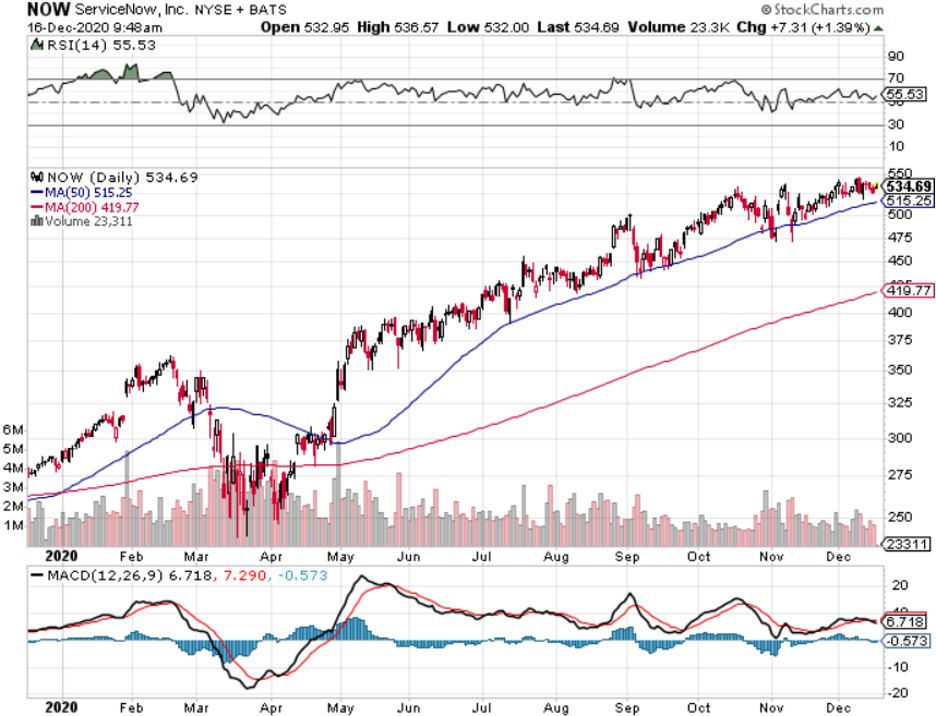
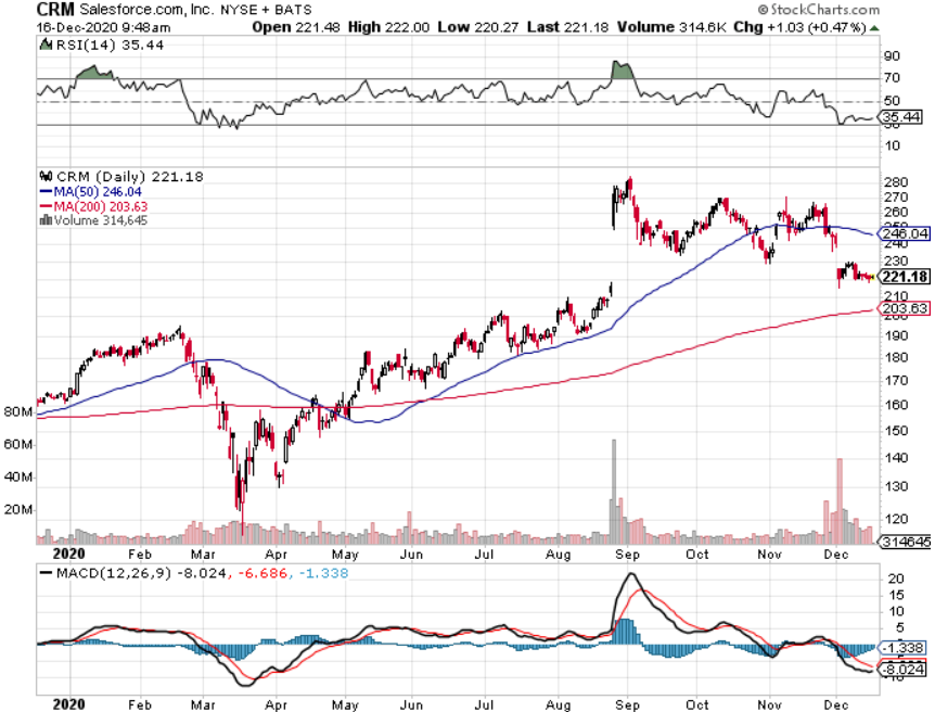
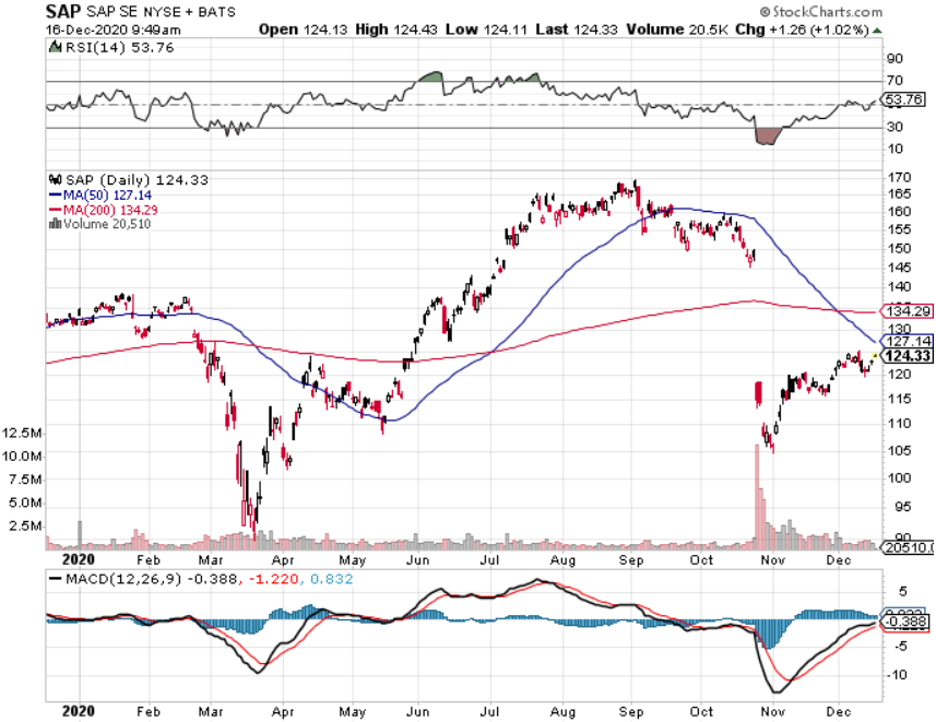
Mad Hedge Technology Letter
July 6, 2020
Fiat Lux
Featured Trade:
(WHY AN OFFICE IN BELGRADE MAKES SO MUCH SENSE)
(OKTA), (SPLK), (CRM), (WKDAY), (TWLO), (NOW)

My nephew paid nothing for phone, transport, internet, utilities during the coronavirus. I’ll tell you how he did it and no, he did not live with his parents or anyone else footing the bills. The future and a massive deflationary wave of technology can be found in how my nephew lives his life.
This is a story about James.
His life is the reason why the U.S. economy will never be the same and highlights the level of metamorphosis going on in our newfound home offices.
The usual culprit of the element inciting change is tech with the aftermath a catalyst for another wave of gigantic deflation.
The statisticians need to check what they are doing because nothing adds up in the deflationary world anymore.
This downward pressure on inflation is likely to be relentless, not just transitory offering central banks more flexibility with corporate accommodative policies without threatening to invoke the specter of inflation.
This is part of the reason why the bull market in tech stocks will be infinite.
Many economists and officials are befuddled, and such worries have never been far from the surface in the period after the financial crisis, the Great Recession, and now Covid-19.
The only thing constant right now is uncertainty.
Technologies are spawning “supply side shocks” in many areas of the global economy by permitting a more intense and efficient utilization of resources.
Also, replacement often leads to the betterment of people’s lives as software disrupts and cannibalizes many established goods and services.
One recent example that couldn’t illustrate this better for the “have nots” is car rental company Hertz, who woke up one day and found their business model shattered into oblivion and obsolete.
James has a modest U.S. income of $4,000 per month, which does not get you anywhere in megacities like New York or San Francisco.
After taking into account car maintenance, gas bills, car insurance, utilities, and rent, there might be $1,000 left over if luck is on the right side.
This type of income just doesn’t cut it in many American cities.
James faced a daunting challenge to acquire the quality of life he desired in most American megacities.
James works for a small start-up tech company, and after he proved to management that he was a legitimate contributor, he quickly asserted his leverage by requesting his manager to sanction a move to a full-time remote position.
Management didn’t want to lose him and reluctantly agreed contingent on a rolling 6-month review.
But James didn’t settle on Bakersfield, California, or even Klamath Falls, Oregon where he could significantly cut his bills.
He chose to take his talents to Belgrade, Serbia.
Deflationary impulse is pervasively spread across economic sectors where its presence has been difficult to note and with James’ housing budget now abroad, his dollars are partially taken out of the U.S. financial picture.
How can such “supply-side shock” manifest itself so quickly? Surely, the supply of land is largely fixed, particularly in areas that have already been urbanized.
The answer lies with technology that created additional capacity of the second industrial revolution, such as increasingly taller high-rise buildings.
Fast forward to today.
A company like Airbnb showcases how digital technologies are allowing more intensive resource utilization. There was abundant accommodation capacity hidden in the world’s cities — but it was not accessible until the internet, smartphone adoption, and Airbnb’s founders’ ingenuity unlocked it.
James is taking advantage of these wrinkles cutting his housing and office bill and crashing his monthly budget to the bare minimum.
James didn’t even feel the need to pay a deposit on a 1-year rental lease choosing to forego rental stability for the optionality of movement.
His Belgrade Airbnb space doubled as his home office.
Airbnb usually offers a 28-day discounted price which is classified as a “long stay.”
Many of these discounts are 30% or more, meaning James only paid $350 per 28 days to live in the Belgrade city center and would move around to different neighborhoods he felt were palatable.
He especially liked the Austrian-Hungarian historical district Zemun and the hipster vibe in Dorchol near the Belgrade City Center.
After the coronavirus hit, these “long term” rentals went from $350 to $200 per 28 days as tourists fled the city centers of Europe, and Airbnb prices crashed with cratering demand.
Why doesn’t James pay for internet, phone, and utilities?
Utilities and Wi-Fi are included in the price of the Airbnb covered by the host along with the furniture and amenities like air conditioning, fully equipped kitchen, microwave, dishwasher, iron, and washing machine.
James has substituted his phone bill opting for chat apps WhatsApp, Skype, FaceTime, Signal, and calls over Wi-Fi.
He keeps a Google Fi phone account to maintain a U.S. number, but keeps it permanently “paused” and only uses it to receive security and verification codes from his U.S. bank, IRS to pay taxes, and mortgage service provider to pay his mortgage online.
He manages to log on to these important portals via a virtual private network (VPN) that routes through a U.S.-based server.
He leases his U.S. house, which he owns, out to a tenant who covers 100% of James’ monthly mortgage costs and handed over his property to a local property manager to be managed.
James doesn’t pay for any transport fees because his city center apartment is walking distance to every main artery in Belgrade giving him access to Turkish-style coffee houses, to Cevapi grilled barbecue shops, to designer Hookah lounges all within a 15-minute walk.
The 2 to 3 times he needs to jump on the tram network to attend a party or night event, he borrows his friend’s yearly transit pass or just skips the fare completely. If he needs to pay, it is 75 cents for a 1-way ticket anywhere in Belgrade.
James has been living out of 2 suitcases for as long as I can remember and has never owned a car, despite growing up in the U.S. and graduating high school and university here.
Although many in the family think he is overly extreme, his intensely minimalistic lifestyle is food for thought; even though he was the first I had ever seen live in such a simplistic, draconian way.
The fallout from the coronavirus and the trends of deflationary technology show that James was ahead of his times when nobody knew it and recently accelerating trends validate his life choices.
James has effectively been planning for a pandemic his whole life which is why he has successfully navigated it, while many Millennials his age have been wiped out, drowned into debt they can never get out of.
If the U.S. suddenly gets tens of millions of James living a variation of his life, many services and products just wouldn't sell in the U.S. anymore. And if they are as extreme as James, housing will crash in all American megacities.
The reality is somewhere in between.
Reinvention is the U.S.’s strong point, but now young people are arbitraging literally everything in their lives, applying a global perspective with a good dose of software to support ultimate goals.
I will assume that most goals end up with obtaining a higher life quality.
Moving forward, investors will need to reprogram their technology compasses around firms that support a “James” type of lifestyle simply because there will be more people like this every day.
Software companies that mesh with this overarching thesis are Okta (OKTA), Splunk (SPLK), Salesforce (CRM), Workday (WKDAY), Twilio (TWLO), and ServiceNow (NOW).
The broader conclusion is that high-quality software stocks will outperform any other sub-sector or sector from now until forever.
As for James, I heard he finally decided to cough up money for local phone data which comes in at a mind-boggling $1 per 1 GB in Belgrade only 10% the cost of the same GB in inexpensive western countries.
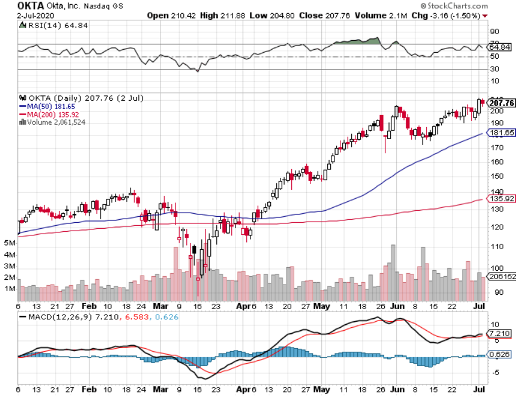
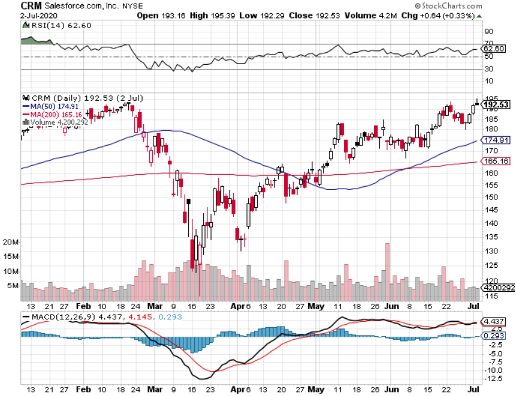
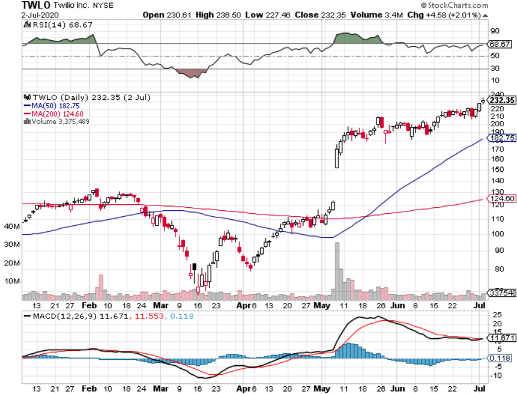
Legal Disclaimer
There is a very high degree of risk involved in trading. Past results are not indicative of future returns. MadHedgeFundTrader.com and all individuals affiliated with this site assume no responsibilities for your trading and investment results. The indicators, strategies, columns, articles and all other features are for educational purposes only and should not be construed as investment advice. Information for futures trading observations are obtained from sources believed to be reliable, but we do not warrant its completeness or accuracy, or warrant any results from the use of the information. Your use of the trading observations is entirely at your own risk and it is your sole responsibility to evaluate the accuracy, completeness and usefulness of the information. You must assess the risk of any trade with your broker and make your own independent decisions regarding any securities mentioned herein. Affiliates of MadHedgeFundTrader.com may have a position or effect transactions in the securities described herein (or options thereon) and/or otherwise employ trading strategies that may be consistent or inconsistent with the provided strategies.
This site uses cookies. By continuing to browse the site, you are agreeing to our use of cookies.
OKLearn moreWe may request cookies to be set on your device. We use cookies to let us know when you visit our websites, how you interact with us, to enrich your user experience, and to customize your relationship with our website.
Click on the different category headings to find out more. You can also change some of your preferences. Note that blocking some types of cookies may impact your experience on our websites and the services we are able to offer.
These cookies are strictly necessary to provide you with services available through our website and to use some of its features.
Because these cookies are strictly necessary to deliver the website, refuseing them will have impact how our site functions. You always can block or delete cookies by changing your browser settings and force blocking all cookies on this website. But this will always prompt you to accept/refuse cookies when revisiting our site.
We fully respect if you want to refuse cookies but to avoid asking you again and again kindly allow us to store a cookie for that. You are free to opt out any time or opt in for other cookies to get a better experience. If you refuse cookies we will remove all set cookies in our domain.
We provide you with a list of stored cookies on your computer in our domain so you can check what we stored. Due to security reasons we are not able to show or modify cookies from other domains. You can check these in your browser security settings.
These cookies collect information that is used either in aggregate form to help us understand how our website is being used or how effective our marketing campaigns are, or to help us customize our website and application for you in order to enhance your experience.
If you do not want that we track your visist to our site you can disable tracking in your browser here:
We also use different external services like Google Webfonts, Google Maps, and external Video providers. Since these providers may collect personal data like your IP address we allow you to block them here. Please be aware that this might heavily reduce the functionality and appearance of our site. Changes will take effect once you reload the page.
Google Webfont Settings:
Google Map Settings:
Vimeo and Youtube video embeds:
